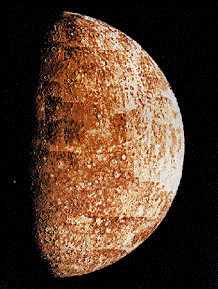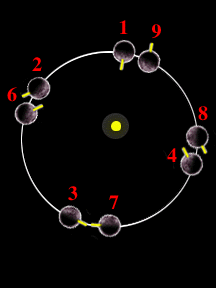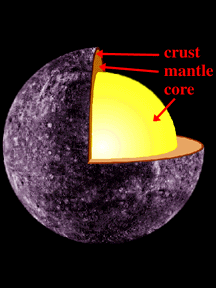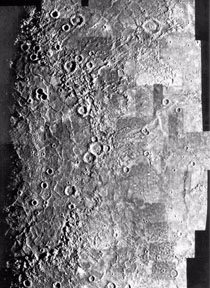One day on Mercury equals 176 earth-days. This drawing follows the position of a single point, in yellow, as Mercury spins (day to night) and as Mercury travels around the Sun (year). The yellow point faces the Sun only once every 176 earth-days or two Mercury years.
Image from: NASA
Mercury's Orbital Resonance
It takes Mercury about 59 Earth days to spin once on its
axis (the rotation period), and about 88 Earth days to complete
one orbit about the Sun. However, the length of the day on
Mercury (sunrise to sunrise) is 176 Earth days. How can this
happen? The figure shows the path of Mercury about the Sun
with a mark indicating the same spot on the surface of the
planet at different times in the orbit. A point initially
pointing toward the Sun will point in the same direction
after one rotation (59 days or 2/3 of the orbital period),
but that point will no longer be directed toward the Sun.
It takes three rotations of the planet during two orbits
of the planet about the Sun, or 88 x 2=176 days, for the mark
to get back to the same position.
You might also be interested in:

How did life evolve on Earth? The answer to this question can help us understand our past and prepare for our future. Although evolution provides credible and reliable answers, polls show that many people turn away from science, seeking other explanations with which they are more comfortable.
...more
Before the Mariner 10 mission of Mercury, it was very difficult to see any markings on the surface of the planet from Earth. This image shows a view of Mercury obtained from a telescope on Earth. The
...more
It takes Mercury about 59 Earth days to spin once on its axis (the rotation period), and about 88 Earth days to complete one orbit about the Sun. However, the length of the day on Mercury (sunrise to
...more
Mercury's orbit is so close to the Sun that it is hard to see from the ground. This is why early astronomers couldn't see it! Viewed from Earth, Mercury is never far from the Sun in the sky. Because of
...more
Mercury, like the other planets, is believed to have formed in the earliest stage of the evolution of the solar system as dust came together to form even larger clumps and eventually small planets or
...more
Mercury, the innermost planet of the solar system, is a little bigger than the Earth's Moon. The surface of the planet is covered with craters, like the Moon, but temperatures there can reach over 80
...more
Mercury has a radius of 2439 km (1524 mi), and the metallic iron-nickel core is believed to make up about 75% of this distance. Measurements of the planet's magnetic field made by Mariner 10 as it flew
...more
The Caloris Basin is the largest feature on the surface of Mercury. This crater was formed by the impact of a large meteorite in the early formation of the solar system. We only know what half of the
...more











